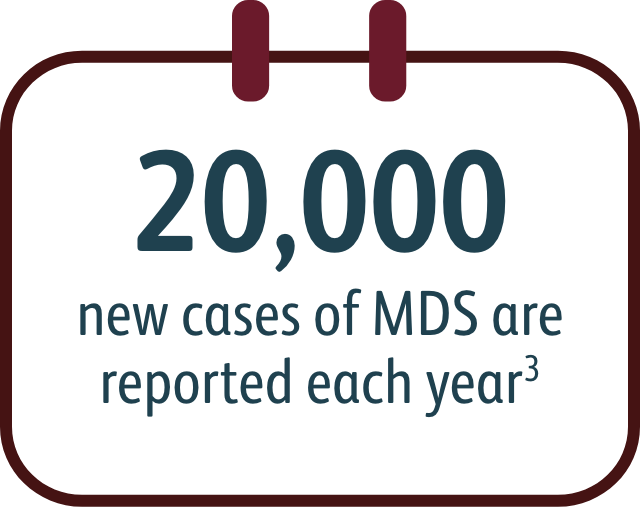This site is intended for US Healthcare Professionals.
Anemia is a prevalent obstacle in myelodysplastic syndromes (MDS)2


Are your patients’ treatment goals being met?
While existing treatments can be effective for some patients, many remain dependent on transfusions, which can make them vulnerable to poorer overall survival.1,8-10
Additional treatment options are needed to address anemia in MDS2
References:
1. Lewis R, Bewersdorf JP, Zeidan AM. Clinical management of anemia in patients with myelodysplastic syndromes: an update on emerging therapeutic options. Cancer Manag Res. 2021;13:645-657. 2. Kubasch AS, Platzbecker U. Setting fire to ESA and EMA resistance: new targeted treatment options in lower risk myelodysplastic syndromes. Int J Mol Sci. 2019;20(16):3853. doi:10.3390/ijms20163853 3. Lymphoma & Leukemia Society. Myelodysplastic syndrome (MDS) research funded by LLS. Accessed April 27, 2023. https://www.lls.org/research/myelodysplastic-syndrome-mds-research-funded-lls 4. Kaka S, Jahangirnia A, Beauregard N, Davis A, Tinmouth A, Chin-Yee N. Red blood cell transfusion in myelodysplastic syndromes: a systematic review. Transfus Med. 2022;32(1):3-23. 5. Ramsey SD, McCune JS, Blough DK, et al. Patterns of blood product use among patients with myelodysplastic syndrome. Vox Sang. 2012;102(4):331-337. 6. Madry K, Lis K, Fenaux P, et al. Cause of death and excess mortality in patients with lower-risk myelodysplastic syndromes (MDS): a report from the European MDS registry. Br J Haematol. 2023;200(4):451-461. 7. Sekeres MA, Maciejewski JP, List AF, et al. Perceptions of disease state, treatment outcomes, and prognosis among patients with myelodysplastic syndromes: results from an internet-based survey. Oncologist. 2011;16(6):901-911. 8. Greenberg PL, Tuechler H, Schanz J, et al. Revised International Prognostic Scoring System for myelodysplastic syndromes. Blood. 2012;120(12):2454-2465. 9. Harnan S, Ren S, Gomersall T, et al. Association between transfusion status and overall survival in patients with myelodysplastic syndromes: a systemic literature review and meta-analysis. Acta Haematol. 2016;136(1):23-42. 10. Malcovati L, Della Porta MG, Cazzola M. Predicting survival and leukemic evolution in patients with myelodysplastic syndrome. Haematologica. 2006;91(12):1588-1590.
